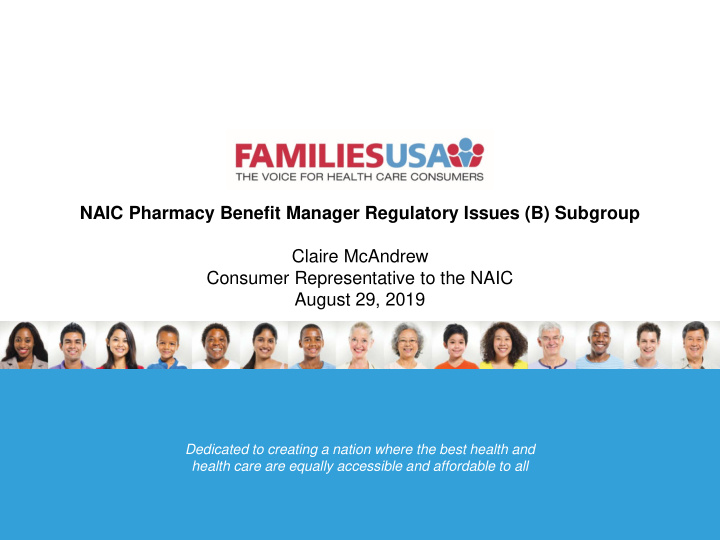



NAIC Pharmacy Benefit Manager Regulatory Issues (B) Subgroup Claire McAndrew Consumer Representative to the NAIC August 29, 2019 Dedicated to creating a nation where the best health and health care are equally accessible and affordable to all
PBMs from the Consumer Perspective Roadmap • How drug costs impact consumers • Costs in the drug supply chain • How states are taking on drug costs • Consumer concerns with pharmacy benefit managers • Addressing consumer concerns with PBMs 2 FamiliesUSA.org
Consumers Struggle with High Rx Costs • Nearly one in three adults have not taken a medicine as prescribed due to its costs • More than one in four consumers decline other medical tests or procedures or put off a doctor’s visit when they experience increased drug costs • Nearly one in three consumers facing increased drug costs spend less on groceries to account for the increase 3 FamiliesUSA.org
Who’s to blame for rising drug prices? The entire drug supply chain is contributing to high and rising drug prices Source: “The future of healthcare”, McKinsey, 2018 4 FamiliesUSA.org
State Mechanisms for Addressing Rx Prices Pharmacy Benefit Transparency Manager Regulations Anti-Price Gouging Affordability Boards Medicaid program Importation reforms 5
Pharmacy Benefit Managers
Pharmacy Benefit Managers: Concerns for Consumers • Lack of Transparency • Lack of Accountability • Incentives to Select High-Cost Drugs • Potential for Higher-Costs at the Pharmacy Counter with Insurance 7 FamiliesUSA.org
Addressing PBM Consumer Concerns Lack of Transparency: Provide clarity on how money flows through entities in the Rx supply chain and therefore how consumer costs are impacted, and by whom. • LA: SB 283 (2018) requires PBMs to make annual “rebate transparency reports” to the insurance department regarding the percentage at which they retain rebates. Information is reported in the aggregate and published on the department’s website. • CT: HB 5384 (2018) requires PBMs to report annually on the share of rebates they retain in the aggregate. Additionally, each year health plans must certify they accounted for all rebates in calculating premiums. • Commissioner prepares an annual public report on the impact of the cost of outpatient prescription drugs on health insurance premiums in the state, and such other information the commissioner deems relevant to the cost of outpatient prescription drugs in the state. • The commissioner prepares an annual public report on the rebate practices of health carriers. It includes: • (1) an explanation of how carriers accounted for rebates in calculating premiums, • (2) a statement disclosing whether and how carriers made rebates available to insureds at the point of purchase during such year, • (3) any other manner in which health carriers applied rebates during such year, and • (4) such other information as the commissioner deems relevant. 8 FamiliesUSA.org
Addressing PBM Consumer Concerns Lack of Accountability/ Incentives to Select High-Cost Drugs: Ensure PBMs do not have incentives to engage in practices that benefit them, not insurers or consumers, such as keeping excessive shares of manufacturer rebates or selecting higher-cost drugs to place on formularies when lower-cost drugs would be in the interest of plans and consumers alike. • Require PBMs to have a fiduciary duty to plans • Maine L.D. 1507 (2019): A carrier that contracts with a pharmacy benefits manager to perform any activities related to the carrier's prescription drug benefits is responsible for ensuring that, under the contract, the pharmacy benefits manager acts as the carrier's agent and owes a fiduciary duty to the carrier in the pharmacy benefits manager's management of activities related to the carrier's prescription drug benefits 9 FamiliesUSA.org
Addressing PBM Consumer Concerns Potential for Higher-Costs at the Pharmacy Counter with Insurance: Ensure consumers can pay the lowest possible price at the counter. If that means they pay cash, this amount should count towards their in-network deductible and out-of-pocket maximum. • Patient Right to Know Drug Prices Act (2018): Federal law that prohibits PBMs and insurers from restricting a pharmacy’s ability to provide an enrollee information on a drug’s price depending on whether it is purchased with the plan or without. (i.e bans “gag clauses”) • Does not require that pharmacists disclose prices. • Does not count costs for out-of-plan purchases towards out-of-pocket caps or deductibles. • CA AB 315 (2018): A pharmacy shall inform a customer at the point of sale for a covered prescription drug whether the retail price is lower than the applicable cost-sharing amount for the prescription drug, unless the pharmacy automatically charges the customer the lower price. (b) If the customer pays the retail price, the pharmacy shall submit the claim to the health care service plan or health insurer in the same manner as if the customer had purchased the prescription drug by paying the cost-sharing amount when submitted by the network pharmacy. (c) The payment rendered shall constitute the applicable cost sharing and shall apply to the deductible, if any, and also to the maximum out-of-pocket limit in the same manner as if the enrollee had purchased the prescription drug by paying the cost-sharing amount. 10 FamiliesUSA.org
Pharmacy Benefit Manager Registration • Registration is a tool, but not a solution by itself for addressing consumer concerns • Registration could be a mechanism to help regulators implement transparency requirements, fiduciary duty or other PBM requirements 11 FamiliesUSA.org
• Takeaways Consumers are harmed by the high costs of drugs Multiple entities in the supply chain, including PBMs, contribute to high drug costs There are many policy levers state regulators can use to address high and rising drug costs for consumers If targeting PBMs, solutions must address transparency, accountability, perverse incentives, and consumer costs PBM registration alone is unlikely to impact drug costs 12 FamiliesUSA.org
Contact cmcandrew@familiesusa.org Dedicated to creating a nation where the best health and health care are equally accessible and affordable to all www.familiesusa.org @claire_mcandrew FamiliesUSA.org
Recommend
More recommend